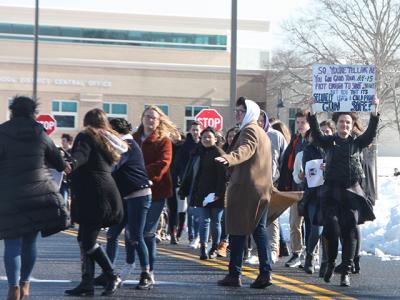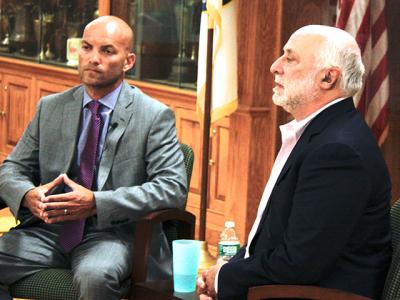Lys Wins Primary, but Unity Is Elusive
Lys Wins Primary, but Unity Is Elusive

A week after David Lys won the East Hampton Democratic primary for town councilman and voters rejected the Reform Democrats’ efforts to remake the town’s Democratic Committee, the local party remains split even as November’s election looms.
Mr. Lys, who was appointed to the East Hampton Town Board in January to fill the seat vacated when Peter Van Scoyoc became town supervisor, handily defeated David Gruber in last Thursday’s Democratic primary.
Unofficial results from the Suffolk County Board of Elections had Mr. Lys winning the contest 1,489 to 884, victorious in all but two of the town’s 19 election districts.
The board of elections received 503 absentee ballots, an official said on Tuesday. Though they have yet to be counted, Mr. Lys’s lead is insurmountable if the unofficial count is certified.
“I think what happened is that the Town of East Hampton decided to go with the moral values of David Lys instead of the moral compass of David Gruber,” Mr. Lys said at Rowdy Hall last Thursday night, a reference to the Reform Democrats’ logo and slogan. “They decided to make sure that the person who stays above the fray and does it for the whole town instead of themselves will always come up above. I always wanted that.”
Mr. Lys will face Manny Vilar, the Republican and Conservative Party candidate, in the Nov. 6 general election. Mr. Vilar lost to Mr. Van Scoyoc in the campaign for supervisor last year. “I think it’s going to be great to talk about the issues, to make sure that the whole town now gets to vote on the candidate, the person that they want to represent them on the town council,” Mr. Lys said. “I hope that’s me.”
The vote was “a reaffirmation of the selection the Democratic Committee originally made of David Lys to be the candidate,” Christopher Kelley, the East Hampton Democrats’ campaign chairman, said on Monday. “It was an affirmation that the Democrats are happy with the job the town board is doing and support the leadership of the party that got them there.”
Looking ahead to the general election, Amos Goodman, chairman of the East Hampton Town Republican Committee, had a different point of view. “This race is really Manny versus the entrenched political machine,” he said yesterday. “It’s a referendum on more of the same versus reform and independence, business as usual versus change. We are confident Manny’s message of experience and independence will resonate with voters.”
But last Thursday, with a contentious primary in the rearview mirror, the mood was jubilant at Rowdy Hall in East Hampton as Mr. Lys and Democratic officials including Supervisor Van Scoyoc, Councilwomen Sylvia Overby and Kathee Burke-Gonzalez, County Legislator Bridget Fleming, Francis Bock, clerk of the town trustees, Susan McGraw Keber of the trustees, and incumbents and candidates for the Democratic Committee watched returns come in on the board of elections website.
The East Hampton Democratic Committee chose Mr. Lys as its candidate in the spring, in the midst of a fraught campaign to select a new committee chair to succeed Jeanne Frankl, who retired. That struggle, in which the Democratic Committee ultimately chose Cate Rogers as its new chairwoman over Rona Klopman, was followed by the establishment of the East Hampton Reform Democrats. Mr. Gruber became its standard-bearer and candidate for the town board.
The Reform Democrats ran a full slate of candidates for the 38-member Democratic Committee last Thursday. Mr. Gruber won a seat in Election District 7, in Wainscott, but he was one of few among his caucus to win. Party leaders including Ms. Frankl, Ms. Rogers, Mr. Kelley, Mr. Bock, Ms. McGraw Keber, and Betty Mazur, the committee’s vice chairwoman, were among the victors. Ms. Klopman was among the Reform Democrats to lose a bid for a seat on the committee. For a full list of people elected to the Democratic Committee last Thursday click here.
The primary election campaign was at turns genteel and punctuated by attacks. Democrats held a 4-0 majority on the town board after the November 2017 election. Mr. Lys’s appointment to the fifth seat angered some Democrats, who complained that Mr. Lys was a lifelong Republican. Indeed, Mr. Lys had only recently changed his party registration from Republican to Democratic. He said, however, that he had never participated in politics before but had come to realize that his views align with those of the Democratic Party.
Since forming the East Hampton Reform Democrats, which he described as a caucus within the Democratic Party, Mr. Gruber has been a frequent critic of the town board, particularly Mr. Van Scoyoc, Ms. Overby, and Ms. Burke-Gonzalez. In mass emails and on social media, the Reform Democrats harshly criticized the town board over its handling of the town’s emergency communications system and the proposed South Fork Wind Farm. At the town board’s meeting on Tuesday, he continued to criticize the board’s actions with respect to the proposed wind farm.
Councilman Jeff Bragman, also a Democrat, joined the Reform Democrats in their criticism of Mr. Lys’s move to form an independent party, the East Hampton Unity Party, to ensure himself a line on the Nov. 6 election ballot were he to lose in the primary. Mr. Goodman has mounted a challenge to Mr. Lys’s Unity Party nominating petitions, which is pending. He said yesterday that he believes Mr. Lys is 50 to 60 valid signatures short of the requirement.
In another unusual aspect of the campaign, the East Hampton Independence Party chose Mr. Gruber as its candidate for town board. East Hampton Republicans, however, challenged the validity of the Independents’ nominating petitions. A State Supreme Court judge sided with the Republicans, and the petitions were invalidated. Mr. Gruber was not involved in the gathering of signatures for the Independence Party petitions.
Ms. Rogers expressed gratitude to Democratic voters on Monday “for overwhelmingly supporting David Lys and the East Hampton Democratic Committee slate. I am proud that running on merit still wins in East Hampton and that attack politics do not resonate here.” She asked that as attention turns to the Nov. 6 election, “all Democrats unite and commit to working together as we always have to continue the good work of electing Democrats for the betterment of our community.”
Last Thursday, his nomination assured, Mr. Lys, the former Republican, also sought to close the chasm that has opened among Democrats. “With time, all rivalries will melt away,” he said to the gathering at Rowdy Hall. “The angst, the anger we might all be feeling will melt away when we all come together as one unified Democratic Committee. That’s what we need to do right now. Let’s go forward. Let’s change Washington, let’s change East Hampton, let’s make sure that we have this on Nov. 6.”
If he wins in November, Mr. Lys will fulfill the final year of Mr. Van Scoyoc’s term and would have to stand for re-election to a full four-year term in 2019, should he wish to continue on the board. “I think I’ve worked hard, I’ve researched hard, I’ve done my homework, and I’m ready to keep going forward for another year,” he said last Thursday.




